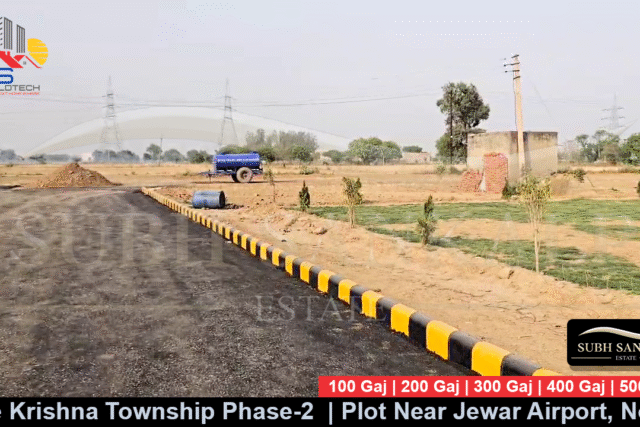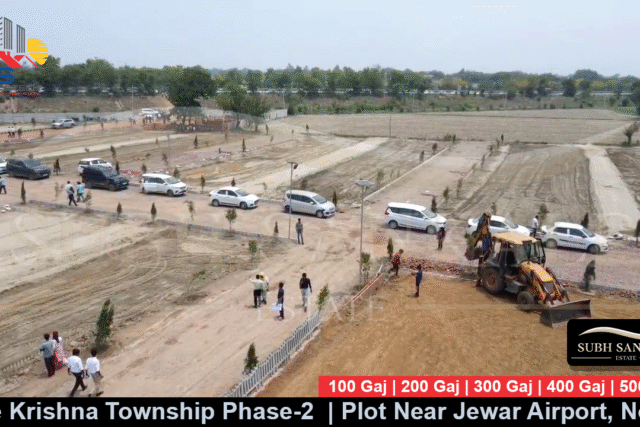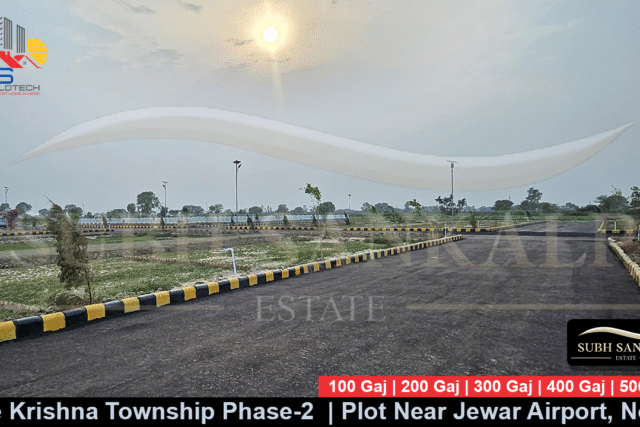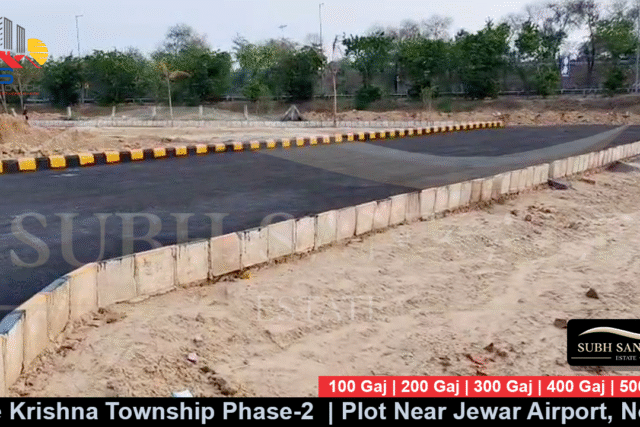The development of the 1500 Gaj Plot Rate Near Jewar Airport – Hare Krishna Township Phase 2 at Jewar has catalyzed a land market of a scale rarely seen in North India. For High-Net-Worth Individuals (HNIs), syndicate investors, and development corporations, a 1500 Gaj plot (equivalent to 13,500 square feet or approximately 1,254 square meters) represents a transition from a simple land investment to an institutional-grade development opportunity. This land parcel size is a strategic canvas for plotted developments, boutique residential societies, commercial complexes, or institutional campuses. Navigating this segment requires a developer’s mindset and a deep understanding of urban planning economics.
The investment for a 1500 Gaj plot places the buyer in a category where the transaction is less about simple resale and more about value creation through development. The pricing matrix for such a large parcel is nuanced, with significant premiums and discounts based on development-ready status.
Current Market Price Matrix for a 1500 Gaj Plot
The capital requirement for a 1500 Gaj plot in the Jewar Airport corridor is substantial, typically ranging from ₹ 1.8 Crores to ₹ 7.5 Crores. This broad range is a direct function of development density, regulatory clarity, and infrastructure completion.
- Institutional-Grade YEIDA Sectors: Plots within fully developed and premium sectors of the Yamuna Expressway Industrial Development Authority (YEIDA) represent the blue-chip asset class. These offer the highest security, complete infrastructure, and the best market absorption for any future development. In these sectors, a 1500 Gaj plot commands a price between ₹ 3.75 Crores and ₹ 7.5 Crores. The price per Gaj may see a slight discount due to the large size, but the total outlay is significant.
- Strategic Development Zones (Approved Townships): This tier includes large, approved private townships and newer YEIDA sectors where development is ongoing. These are prime targets for forward-looking developers. Prices here generally range from ₹ 2.25 Crores to ₹ 3.75 Crores for a 1500 Gaj plot. This zone offers the ideal blend of future growth and a viable project cost base for plotted or villa projects.
- Strategic Land Assembly Zones (Future Urban Frontier): This refers to large land parcels in villages or on the immediate urban fringe, often requiring aggregation. This is a pure land banking and development bet. Prices here can start from ₹ 1.8 Crores to ₹ 2.25 Crores. This tier carries the highest risk—including potential delays in zoning changes and infrastructure rollout—but offers the highest potential return if the area is integrated into the urban fabric as planned.
Critical Value Drivers for a 1500 Gaj Development Plot
At this scale, valuation shifts from a simple per-Gaj calculation to a project-based feasibility analysis.
- Development Economics (FAR/FSI and Ground Coverage): The permitted Floor Area Ratio (FAR) is the single most critical factor. A higher FAR on a 1500 Gaj plot dramatically increases the saleable area potential, directly justifying a higher land cost. Ground coverage norms and height restrictions equally influence the project’s design and profitability.
- Infrastructure Liability and Development Charges: A plot in a sector where external development charges (EDC) and internal development charges (IDC) are already paid commands a significant premium, as it reduces the developer’s upfront cash outflow. The condition and capacity of existing roads, water, sewage, and electricity lines are paramount.
- Zoning and Land Use in the Master Plan: The designated land use (Residential, Commercial, Mixed-Use) in the official YEIDA or local authority master plan dictates the entire project’s scope and revenue potential. A commercial designation can multiply the land’s value compared to a residential one.
- Topography and Development Readiness: The physical condition of the land—its topography, soil quality, and freedom from encumbrances like high-tension lines or right-of-way—directly impacts the project’s timeline and earthwork costs. A flat, clear plot is a premium product.
Investment Rationale for a 1500 Gaj Plot
A 1500 Gaj plot is a project, not just an asset. It is a platform for value creation. The investment rationale is based on active development rather than passive land banking. The potential uses are extensive:
- Plotted Development: Subdividing into smaller plots (e.g., 300-400 Gaj each).
- Boutique Gated Society: Developing a cluster of villas or row houses.
- Institutional Campus: For a school, hospital, or corporate training center.
- Commercial Complex: For retail or office spaces, subject to zoning.
This scale allows an investor to shape the micro-market, creating a product that caters to the massive demand generated by the airport’s operational ecosystem.
1. For a 1500 Gaj plot, is the per Gaj rate lower than for a 500 Gaj plot?
Yes, typically. Large land parcels often transact at a lower per-unit cost. This is due to the “volume discount” principle and the fact that the buyer pool for such large plots is much smaller. While a 500 Gaj plot may fetch ₹ 28,000/Gaj in a premium sector, a 1500 Gaj plot might trade at ₹ 25,000-₹ 27,000/Gaj, reflecting the discount for a bulk purchase.
2. What is the process and feasibility of subdividing a 1500 Gaj plot?
Subdivision is entirely possible but is strictly governed by the regulations of the development authority (e.g., YEIDA). The process involves:
- Obtaining a formal subdivision approval from the authority.
- Ensuring each new plot meets the minimum lot size requirements.
- Surrendering land for internal roads and open spaces as per norms.
- Payment of applicable subdivision charges. It is a technical process best handled by a certified architect and lawyer.
3. What are the major hidden costs in a development-focused plot acquisition?
Beyond the sale price, a developer must budget for:
- External & Internal Development Charges (EDC/IDC): If not paid.
- Stamp Duty and Registration: A significant amount on a crores-long transaction.
- Legal and Brokerage Fees.
- Authority Approval Costs: For building plans, subdivision, etc.
- Land Holding Costs: Property tax until construction begins.
4. How does a 1500 Gaj plot compare to 1 Bigha?
In the local measurement system around Jewar, 1 Bigha is traditionally equal to 2,500 Gaj. Therefore, a 1500 Gaj plot is 0.6 Bigha. For transactions of this scale, a certified survey from an authority-approved surveyor is mandatory to confirm the exact dimensions and area.
5. Is a Joint Venture with the landowner a common model for a plot this size?
Extremely common. The standard model is a Joint Development Agreement (JDA), where the landowner contributes the plot, and the developer contributes all capital and expertise for construction and sales. The revenue share is typically in a ratio like 60:40 or 50:50 in favor of the landowner, but this is highly negotiable. A watertight JDA drafted by an expert real estate lawyer is critical to protect all parties.
















Leave a review for 1500 Gaj Plot Rate Near Jewar Airport – Hare Krishna Township Phase 2